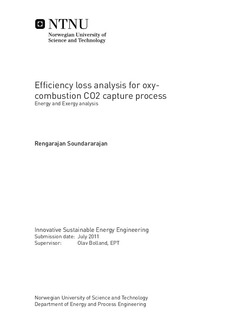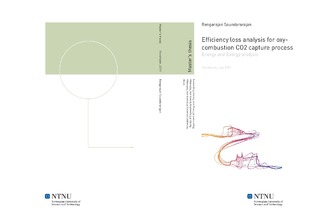| dc.contributor.advisor | Bolland, Olav | nb_NO |
| dc.contributor.author | Soundararajan, Rengarajan | nb_NO |
| dc.date.accessioned | 2014-12-19T11:47:04Z | |
| dc.date.available | 2014-12-19T11:47:04Z | |
| dc.date.created | 2011-10-14 | nb_NO |
| dc.date.issued | 2011 | nb_NO |
| dc.identifier | 448155 | nb_NO |
| dc.identifier | ntnudaim:6354 | nb_NO |
| dc.identifier.uri | http://hdl.handle.net/11250/234462 | |
| dc.description.abstract | Natural gas combined cycles with oxy-fuel combustion is expected tobe an important component of the future carbon constrained energyscenario. An oxy-combustion power cycle enables the fuel to burn in anitrogen free environment and thereby helps separate the CO2 streamfor storage. Depending on the oxygen source and purity, the CO2stream may need further purification via a purification unit (CPU)before compressing it to a high pressure for storage. The major energy penalty in this type of power cycle is the production of oxygenand the downstream purification to remove volatiles. It is this energypenalty which results in the cost of avoiding the CO2 emissions to theatmosphere.Cryogenic Air Separation Units (ASU) for oxygen production con-tribute to approximately 20% of the total energy penalty of such powerplants. Oxygen Transport Membranes (OTM) for oxygen production offers a potential solution to reduce the energy penalty of oxy-combustion natural gas cycles. The energy penalties associated withOTMs are that membranes operate at high temperatures and requirea sweep gas to establish an oxygen partial pressure difference betweenthe feed and permeate streams. Further, while the Cryogenic ASUhas minimum integration with the power process, oxy-combustion cycles with OTMs are tightly integrated with the power plant. Thusthe contributions to efficiency penalty in an OTM-based cycles aredistributed and not easily identified.The objective of the thesis is to answer the question: "Where doesthe plant efficiency loss originate in oxy-combustion CO2 capture process using Oxygen Transport Membrane as compared to one withcryogenic ASU?" The contribution of the work will be to highlight thelosses at the sub-process and at the equipment level.This work studies three different cases of oxy-combustion naturalgas combined cycles (NGCC) with CO2 capture. The baseline scenario, modified/improved scenario and the advanced scenario. Thebaseline scenario is a simple oxy-combustion NGCC power plant withASU as the oxygen source. Various losses associated with this systemare studied in detail. The modified/improved scenario involves analysis of possible modifications to the baseline case and applying theresults in-order to improve the baseline case. The modified scenario isexpected to have a better overall plant performance. The advancedscenario involves usage of OTM for oxygen production.The power plants are simulated in Aspen HYSYS and plant massand heat balances are calculated. Using the stream enthalpy, entropyand composition, we can calculate the stream exergy values. Controlvolumes help us analyze the component and sub-system exergy lossesand arrive at the overall power plant exergetic efficiency. The base-line power plant scheme is found to have an exergetic efficiency of 47percentage points with a thermal efficiency of 49.6 percentage, withcapture.The modified power plant scheme is obtained by increasing the gasturbine pressure ratio and this has a significant impact on the over-all system design and hence the performance. The modified systemhas exergetic and thermal efficiency of 49 and 51 percentage pointsrespectively. The advanced power plant with OTM, also called as theAdvanced Zero Emissions Powerplant (AZEP) has an exergetic efficiency of 51 and a thermal efficiency of 53.4 percentage. In all the cases, the combustor where most of the fuel is burnt is responsible formajority of the exergy destruction.There is potential for improving the ASU and thereby achieving alesser specific oxygen production power and also due to system integration and other improvements, the overall oxy-combustion NGCCpower plant is expected to play an important role in 5 - 10 years. Alsoas the working fluid is different from that of a normal air based powerplant, significant work needs to be done in the gas turbine and compressor part. Also detailed cost estimations, reliability and flexibilitystudies, operability and safety related studies need to be carried outin-order to boost the confidence in oxy-fuel NGCC power plants andtake it to the next phase. | nb_NO |
| dc.language | eng | nb_NO |
| dc.publisher | Institutt for energi- og prosessteknikk | nb_NO |
| dc.subject | ntnudaim:6354 | no_NO |
| dc.subject | MSISEE Innovative Sustainable Energy Engineering | no_NO |
| dc.subject | Carbon Dioxide Capture | no_NO |
| dc.title | Efficiency loss analysis for oxy-combustion CO2 capture process: Energy and Exergy analysis | nb_NO |
| dc.type | Master thesis | nb_NO |
| dc.source.pagenumber | 115 | nb_NO |
| dc.contributor.department | Norges teknisk-naturvitenskapelige universitet, Fakultet for ingeniørvitenskap og teknologi, Institutt for energi- og prosessteknikk | nb_NO |

